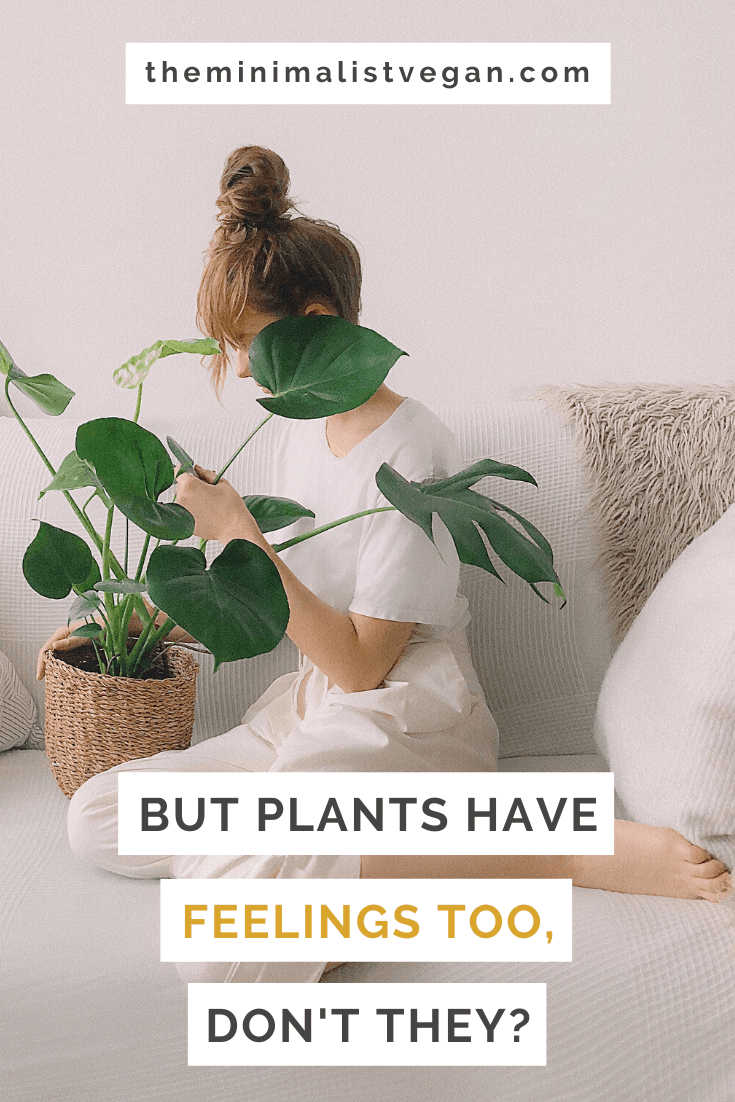What Do Animals Have That Plants Don't
Do plants feel pain? Do they have feelings?
Every bit y'all process these questions, you probably take a natural assumption that plants exercise or exercise non feel pain.
Whatever your stance, it may seem pretty straightforward. Equally it turns out, the answer to this question tin can be complex.
If y'all're vegan, you probably blench every time someone tells you, "but, plants have feelings likewise". Or ask, "if y'all care about killing animals, why don't yous intendance near killing plants?"
Then you non-confidently mumble back a response about how plants don't have a central nervous organization so scientifically, they tin can't feel hurting.
While this statement is somewhat true, in that location's more than to consider about the sentience of plants.
I get the intent behind the questions. If plants have feelings and tin feel pain, then what's the deviation between eating animals and plants? Why is in that location a hierarchy of suffering?
This post is my endeavour to nowadays arguments for and against the "plants have feelings too" debate, before weighing in on my own opinion towards the finish.
Allow'southward get into it.
What's pain, and how does it piece of work?
To understand if plants experience pain, we must first define what pain is.
A quick Google search reveals that pain is a highly unpleasant physical sensation caused by illness or injury.
Okay, that seems pretty obvious. Let'southward go a little more than specific.
Animals (homo and not-human) perceive hurting through sensory nerve cells. The same network of cells that process our sight, touch, scent, hearing and gustation.
As explained in the textbook Pain and Disability: Clinical, Behavioral, and Public Policy Perspectives, pain receptors which are present in most body tissues, respond to damaging or potentially damaging stimuli.
Letters initiated by this stimuli are transmitted past nervus cells to the spinal cord and the brain (your fundamental nervous system). If the brain perceives the threat to be legitimate, it responds by creating a sensation of pain to direct attention to the body function so that the danger can exist mitigated.
Information technology'due south like if you were to hit your large toe on the bottom of your bed frame. The bear upon of the connection creates stimuli. From there the nerve cells get sent to your encephalon, which the brain approves and creates the awareness of pain to your big toe.
With this data, yous analyse the risk of further pain by avoiding repeated action. Additionally, your brain signals to not to put pressure level on your toe to give it time to heal.
We must besides remember that hurting is a subjective emotion, not but a concrete response. This is why animals tin can feel circuitous hurting-related emotions like fear, sadness and acrimony.
For example, a cow can experience trauma from being separated from her calf afterward nativity, much like how a human mother could experience the aforementioned emotional pain in the aforementioned situation.
To summarise, pain is the process of turning stimuli into a subjective emotional experience to mitigate future take chances and promote healing.
What's a found?
Plants are living organisms that come in many different forms. We've come up to know them equally trees, shrubs, herbs, grasses, ferns, and mosses.

There are three bones structures of a constitute:
- Leaf – the leaf is an organ of a constitute that captures free energy from sunlight. Leaves also collect carbon dioxide from the air.
- Stem – the stem is the core structure of a institute that supports leaves, branches and flowers. Stems have vascular tissues that move food and water effectually the found to assistance information technology thrive and grow. Plants often store food in stems.
- Roots – the roots of a found abound underground and help the found stay balanced while also gathering minerals and water from the soil. Some plants store food in their roots.
There are almost 400,000 found species, and scientists are discovering more each day.
To put it simply, plants rule the world—representing fourscore per cent of the globe's biomass.
Personally, I dear plants as we owe our existence to them.
They provide nutrient, shelter, shade, clean air and beauty. Plants, in many ways, represent life.
It's essential to acknowledge the overwhelming significance of plants as we consider the emotions of this infinitely generous species.
A example for why plants feel pain and have emotion
In this side by side section, I break down three case studies that are regularly referenced when making an argument that plants feel hurting.
Where possible, I've linked to the papers for your perusal.
1. Plants tin can hear themselves being eaten by caterpillars
In a paper published in 2014 titled Plants respond to leaf vibrations caused by insect herbivore chewing, researchers plant plants increased their chemical response to the vibrations caused by a caterpillar chewing.
The study involved placing caterpillars on plants called Arabidopsis, then using lasers and reflective materials to mensurate the move of the leafage in response to the caterpillar munching.
The recordings of the caterpillars feeding vibrations were played back to a ready of plants and played silence to another set of plants.
It was found that the plants that had been forced to listen to the sound of the vibrations from the munching produced more mustard oils, which are chemicals insects don't like.
The argument here is that plants answer to pain by producing defense force mechanisms when they notice a threat.
2. Plants can communicate with each other
In a paper published in 1983 titled Rapid Changes in Tree Leaf Chemistry Induced past Damage: Evidence for Communication Betwixt Plants, researchers establish signs of communication amongst maple trees as a response to intentionally cutting their leaves.
Specifically, increased rates of synthesis and phenolic compounds were institute amongst a grouping of maple seedlings 52 hours afterward having seven per cent of their foliage area removed from vehement.

The statement here is that plants can release chemicals as a form of communication to warn other plants of the threat, as a reaction to pain.
This newspaper was met with a lot of controversies as early studies could non be replicated.
So another paper published in 2014 titled Volatile communication between plants that affects herbivory: a meta-analysis, stating that they found 48 well-replicated studies since the 1983 research. Through their meta-analysis, they found overall back up for the hypothesis that resistance increased for individuals with damaged neighbours.
Just like about research, they stated in the conclusion that more testing is required for consistency of results, and adapted for environmental variables. For example, all of the studies reviewed so far occurred in a lab, not in nature, which may be a factor when analysing the communication between plants.
The other question marking in the testing is the lack of reciprocation in communication between the plant subjects. Information technology appears that when herbivores assail a plant, the plant emits communications to others, but at that place's no evidence of the other plants communicating to the emitter.
This suggests that the response of the emitter is more than of a bulletin or broadcast of warning, as opposed to a weep for help.
3. Plants are reportedly "screaming" when under stress
In a paper published in Dec 2019 titled Plants emit informative airborne sounds under stress, researchers constitute that plants emit high-pitched sounds when threatened.
Specifically, they recorded the audio waves over some time for tomato and tobacco plants when dry, cutting, and normal.
The results showed that when the institute was nether stress, e.g. dry or cut, they constitute the plants began to emit ultrasonic sounds betwixt twenty and 100 kilohertz.
Plants emit sounds that humans can't hear (without assistance), so the researchers used ultrasonic microphones to find the sound waves in the study.
Continue in mind that this paper is non peer-reviewed at the time of publishing this post.
Merely the results do heighten an interesting chemical element to the "plants have feelings" debate.
If plants are, in fact, screaming when nether stress, we can make some assumptions that they do at least react to pain.
A case for why plants don't feel pain and accept emotions
Whether it'southward reacting to vibrations, sending warning signals, or literally screaming, we withal take much to learn most plants.
These examples together are put forward a compelling case for plants being able to experience hurting.
Having said that, the argument for why plants don't feel pain or emotions doesn't demand much explaining. It all comes downwards to biology.
Every bit explained earlier in this post, hurting is an experience that incorporates communication betwixt stimuli, receptors, cells, and the cardinal nervous arrangement.
It'southward ane affair to simply react to a threat, and it's another thing to intellectualise it.
Animals suffer from pain considering they consciously process pain. It's the brain and spinal cords which make the states aware of the pain, again, which is a subjective response based on circuitous emotions.
The examples of plants releasing chemicals and sounds without the processing from a fundamental nervous organisation can be considered to be a basic stimulus-response.
It's similar to how plants react to stimulus from the sunday, water, or soil.
These responses draw comparisons to technology. For instance, when you press the button on a doorbell, it responds by making a racket.
Or when the battery on your phone gets low, information technology responds past flashing.
These are responses, non intellectually processed emotions.
The famous Venus flytrap plant
Another example that is perhaps more than relevant than engineering is the well-known constitute, Venus flytrap.
Venus flytrap is a cannibal plant that eats insects, frogs and human flesh if given the opportunity.
This unusual plant lures in prey by using sweet scent from its nectar. Once the casualty is at the jaws of the Venus flytrap, the institute gets set to snap close.
Professors from the University of Tasmania have said that Venus flytraps don't recognise animals; they reply to mechanical stimulation.
This is further proven past the Venus flytrap responding to a cigarette placed in its jaws.
Cannibal Constitute Smoking a CIGARETTE (捕蠅草)
If the found had a central nervous system, information technology would be able to consciously discern its prey to eat the nigh optimal nutrients for its biology.
Yous tin't just give any animal a rock to eat—they would consciously procedure potential nutrient using their sensory cells and their brain. It's the same system used to process fear, sadness and suffering.
My final thoughts on whether plants have feelings
There's no question that nosotros're learning more about plants every year, and the research most how they respond to stimuli is fascinating.
Merely even after reading the inquiry, I couldn't see whatever articulate peer-reviewed show of plants showing anything beyond mechanical response to stimuli.
The examples of plants responding to cuts, munching on leaves and drought seem obvious to me. Plants besides react to music, quality soil, surrounding objects and sunshine.
Does it mean that they're consciously responding to these situations? I recall not.
Now, are plants living organisms? Absolutely, and humans generally treat them that way. Nosotros often refer to a plant as happy, distressing, dead or live.
But the absenteeism of a brain limits a plants ability to take stimuli and process a conscious subjective response. Well, equally far as nosotros know.
So while I can't definitively say that plants don't have feelings, I've seen more evidence that they don't.
For me, the deal-billow is the difference between a mechanical response and a conscious response.
I'd dear to hear from you at present. What do you think? Practise plants have feelings?
What are your thoughts on mechanical and conscious responses to threats? Let me know in the comments beneath.
Yous may also similar…

Source: https://theminimalistvegan.com/do-plants-have-feelings/
Posted by: nolandrowend.blogspot.com

0 Response to "What Do Animals Have That Plants Don't"
Post a Comment